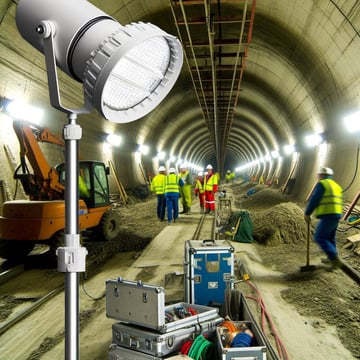September 26, 2024
Choosing the Best Lighting for Harsh and Hazardous Environments
Written by: Brian Earl
Selecting the right lighting fixture when working in Harsh or Hazardous environments is critically important to worksite and worker safety. Several important considerations are critical to ensure a safe work environment.
This blog will discuss applications in atmospheres requiring watertight, harsh, and hazardous lighting applications.
Harsh lighting environments may include areas that are corrosive or waterborne, where fixtures are exposed to spray, temporary submersion in chemicals, or saltwater-laden regions. Examples include inside a food plant, municipal water or wastewater facilities, refineries, shipboard locations, or outdoor areas near the ocean or petrochemical plants. These environments are particularly challenging due to the wide range of potential hazards.
In these, consider fixtured designed to 6P (temporary submersion at 6’ for 24 hours) rating and those that carry a IP67, watertight ratings as well.
Hazardous areas typically defined as those with explosive dust, flying or vapors, that in sufficient quantity cause danger to lighting fixtures or workers occupying these areas. Last months Blog Post included discussion around “Confined Space Entry” and challenges surrounding this area. This month I will discuss Hazardous areas beyond confined spaces.
Hazardous Atmospheres - An atmosphere which poses a danger to both the location/equipment and workers. Hazardous atmospheres defined as:
- Flammable – known as enriched oxygen atmospheres, vaporization of flammable liquids, chemical reactions, and concentration of combustible dust or absorption of chemicals from inner surfaces of the confined space.
- Toxic - entire spectrum of gases, vapors, and air-borne dusts. Examples of toxic atmospheres are manufacturing processes such as charcoal, product storage such as removal of a substance from a tank or maintenance work such as welding in a confined space.
- Irritant/Corrosive - these types of atmospheric hazard have primary and secondary groups.
- Primary irritants exert no systemic toxic effects because the products formed by them on tissues of the respiratory tract are non-irritant and other irritant effects are so violent as to obscure any systemic toxic action. Examples are chlorine, ozone, and hydrochloric acid.
- Secondary irritants may produce systemic toxic effects in addition to surface irritation. In most cases, the worker is not aware of any increase in the exposure to these hazardous toxic substances. - Asphyxiating – Deficiency in the proper amount of Oxygen. Reduction of oxygen in a confined space may be the result of either consumption or displacement.
- Ventilation - OSHA does not define the number of air exchanges required (some states offer requirements for this), but the typical rule is to have at least five complete air exchanges per hour.
For more information about confined spaces and the requirements surrounding them, visit the OSHA website.
Now that we have outlined challenging areas that require task lighting, there are specific requirements for lighting products used in these spaces.
Confined and hazardous spaces are dangerous for all sorts of reasons, without the risk of electrocution added to the list. Task lighting used in these spaces needs to meet specific atmospheric requirements and contain any internal explosion as well. For example, lighting used in confined spaces with or without hazardous vapors must either be low voltage; defined here as 12-volt AC or include GFCI protection.
Additional considerations for safety departments, include safe egress for workers if there is a power outage. In these, using a lighting product with 90-minute battery back-up ensures workers can safely exit hazardous, confined or workspaces safely. Ericson has a wide selection of work lights specifically designed to provide resistance to atmospheric vapors and demands of a rugged work environment.
Since 1918 Ericson has been a leader in lighting for demanding and hazardous locations. Click on any of the product references below and download our Confined Space Solutions Guide to learn more about how Ericson can make your job site safer.
Brian Earl
Hailing from Minnesota originally, Brian began his secondary education at the University of Minnesota with his undergraduate work and his MBA in Management at University of Michigan, focusing on strategic marketing and market planning. He has an extensive background in developing and leading a variety of marketing,...
More from the blog
View All Posts
Workplace Safety
17 min read
| August 20, 2024
Industrial Grade Job site Lighting Solutions for Confined Spaces
Read More.png?length=360&name=MicrosoftTeams-image%20(69).png)
New Product Launch
4 min read
| March 21, 2024
Upgraded Harsh & Hazardous Lighting Solutions
Read More.png?length=360&name=MicrosoftTeams-image%20(54).png)
New Product Launch
4 min read
| March 21, 2024
Introducing HL and WL Industrial Handlamps
Read MoreSubscribe to blog updates
Stay up-to-date on what's happening at this blog and get additional content about the benefits of subscribing.
